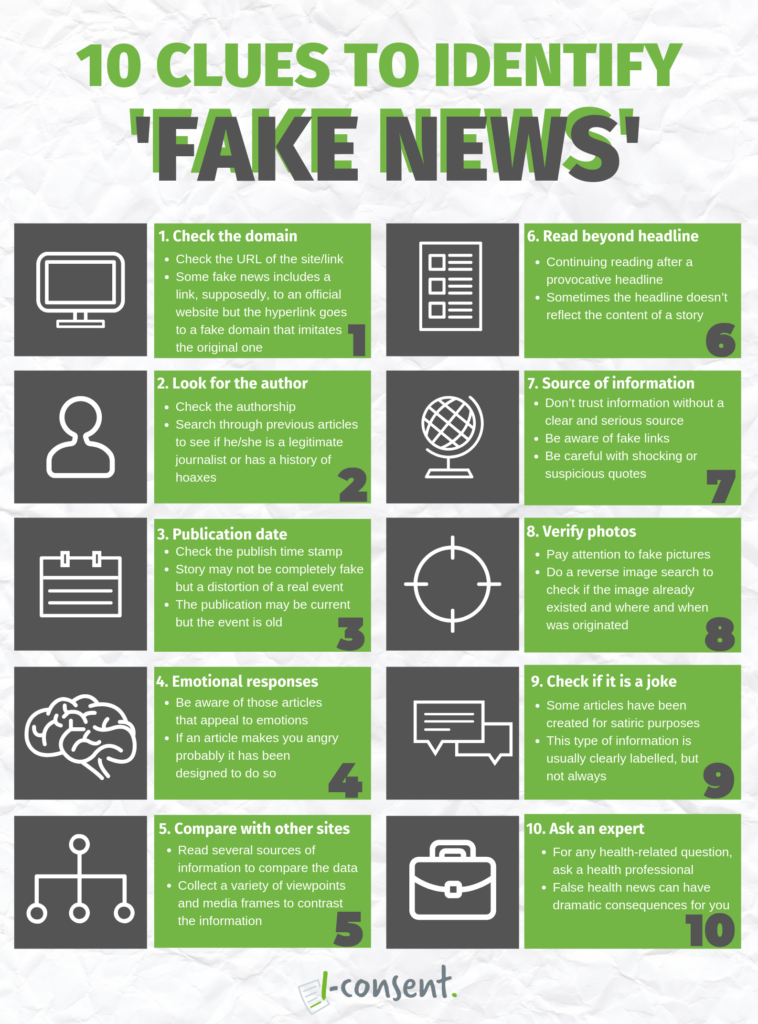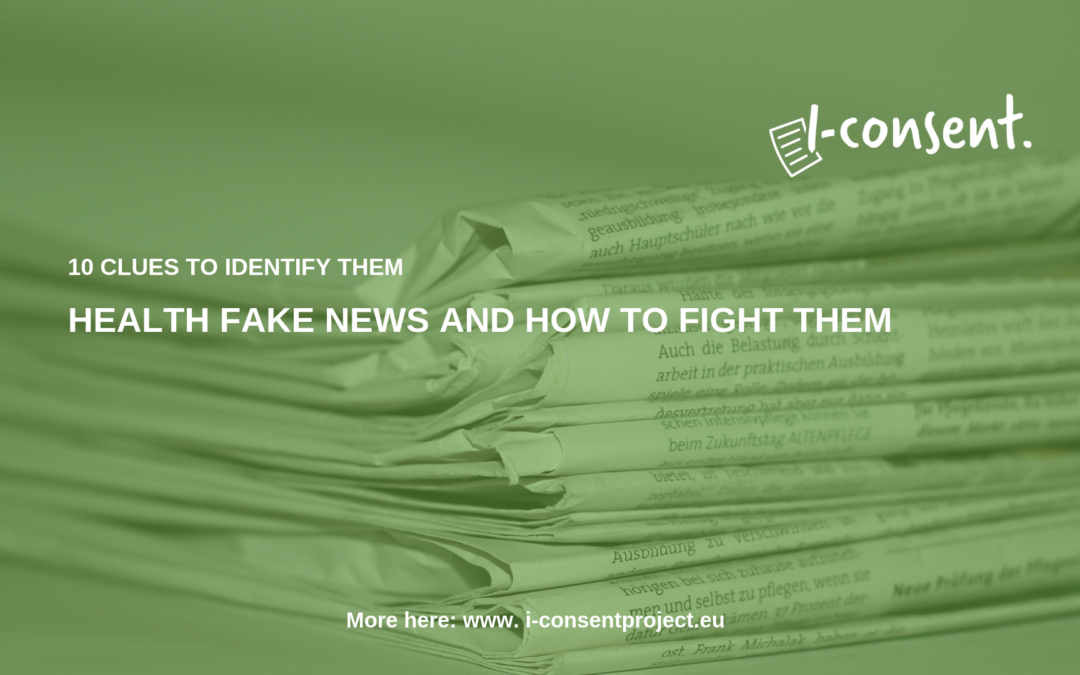Fake news have currently become one of society’s major concerns, the harm they produce in several fields as politics or health, or their impact in individual and collective memories, has placed them on the spotlight. Society’s perception of their influence and importance increased after the 2016 U.S. Presidential Election.
What are fake news and what types are there?
There are different definitions and classifications for the expression “fake news”. Some authors consider fake news only news articles (Allcott and Gentzkow) while others, such as Melissa Zimdars, include other kind of fake information, and classifies them in four categories (each piece can be in more than one category):
- Fake, false, or regularly misleading websites shared on social media.
- Websites circulating misleading and/or potentially unreliable information or presenting opinion pieces as news.
- Websites that sometimes use hyperbolic or clickbait-y headlines and/or social media descriptions and other times circulate reliable and/or verifiable information.
- Satire/comedy sites that have the potential to be shared as actual/literal news.
How can people identify fake news?
Due to the increasing use of social media, it is very important to empower and give citizens the necesary tools to be able to critically think when deciding the sources of information that they trust and what information share on their Social Media.
Taking into account the recommendations from different websites and documents, i-CONSENT presents 10 key clues to identify fake news as part of its health literacy objective:

1. Check the domain
It is very important to check the URL of the site/link. Zimdars recommends avoiding websites that finish in “lo”, such as “Newslo”, she explains that these sites take pieces of real information and mix it with false or misleading “facts” (sometimes for satire or comedy purposes). She also indicates that some fake websites use domains that are very similar or try to copy reputable news organisations, for example adding “.com.co” at the end. It is also important to differentiate news sources from personal blogs, if the title of the domain contains words such as “.wordpress” or “blogger” it is probable a personal blog.
Some fake news include a link, supposedly, to an official website but the hyperlink goes to a fake domain that imitates the original one.
Zimbars also recommends checking the “About us” section, looking up the website on Snopes or Wikipedia to get more information about the source. The “Breaking news consumer’s handbook ” developed by the New York Public Radio WNYC suggest to google the name of the website with the word “fake” and see what comes up.
When the news arrive via WhatsApp it is also useful to check if the message has the “Forwarded” label, in that case the message is not original from the person who sent it to you.
2. Look up the author
Before trusting the information, it is important to check the authorship. Zimdars indicates that when the author doesn’t appear you should be careful and she recommends a verification of the information.
If the author appears, Robins-Early recommends to searching through his/her previous articles to see if he/she is a legitimate journalist or has a history of hoaxes.
Librarians from Indiana University East recommend checking LinkedIn or searching for the author in Google to see if he/she has the background needed to speak about that topic with authority and accurancy.
3. Publication date
Kiely and Robertson indicate that sometimes the story isn’t completely fake but a distortion of a real event. For instance, one may take an old story and resurface it as if it just happened to link it with current events.
Robins-Early recommends to check the publish time stamp. He also highlights that sometimes the date of the article is current but the event is old. To detect this one needs to click through several links and read carefully, to identify when the event happened.
4. Emotional responses and biases
Zimdars indicates that the texts with outstanding headlines and/or body text all in capital letters often try to create emotional responses with readers that is avoided in more traditional styles of journalism. Spot words such as WOW!, SLAUGHTER!, DESTROY!
We should be aware of the news that appeal to emotions because it is very common that fake news do so. If reading an article makes us angry it probably has been designed for that purpose.
5. Search in reputed news sites
Zimdars recommends to further read through the topics we are interested in in other sources to check if the information is real or fake.
Zimdars recommends checking if known/reputable news sites report on the story. She also mentions that it is better to read multiple sources of information to get a variety of viewpoints and media frames.
Boatner indicates that the real stories appear in many publications, so if it doesn’t appear in several newspapers, journals or websites probably it will be fake. She also highlights that if the story comes from a newspaper, magazine, or website you’ve never heard of it is better to get information from it before taking it seriously.
6. Read beyond the headline
Kiely and Robertson recommend to further read after a provocative headline. Sometimes the headline doesn’t reflect the content of a story and are writen to provoke and trigger a reaction in the audience.
They point out that the headline may not tell the whole story, even in legitimate news stories. Fake news, specially satirical ones, can include several revealing signs in the text.
7. Check the source
It is recommended to don’t trust information without a clear and serious source.
Robins-Early indicates that a warning sign of a fake news is its lack of links or sources of information. He points out that sometimes fake news provide links to sites that seem to support their information, but are actually sites that disseminate misinformation. He recommends verifying that reliable sources support and confirm the information.
Kiely and Robertson highlight that sometimes the story will cite official sources, but when you look into them they don’t support the claim at all. Also, when giving a graphic to support the information, it doesn’t correspond with the real data or doesn’t exist.
Robins-Early recommends to be sceptical when reading shocking or suspicious quotes, and verify if they have been reported in a known/reputable source.
8. Verify photographs
Robins-Early highlights that some pictures that appear in a news can be from another event or can be altered for a certain story. He recommends to do a reverse image search, through Google or other tools such as TinEye, to find if the image already existed and where and when it was originated.
9. Confirm it is not a satiric publication
Some news have been elaborated for satiric purposes. These type of information is usually clearly labelled, but some people take them as real. Be careful not to confuse real news with those created just for fun.
10. Ask the expert
If you have healt-related questions about yourself or a clinical research you are taking part in, ask a health professional or investigator directly.
Consider always asking him/her before taking any decision from information that comes from a news or Social Media. You can talk with him/her about what worries you. He/she can provide you information and trustful resources to verify the information or put you in contact with a specialist that can help you.
Keep in mind that false health news can have dramatic consequences on your health.
